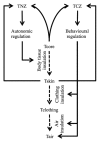Beyond the classic thermoneutral zone: Including thermal comfort
- PMID: 27583296
- PMCID: PMC4977175
- DOI: 10.4161/temp.29702
Beyond the classic thermoneutral zone: Including thermal comfort
Abstract
The thermoneutral zone is defined as the range of ambient temperatures where the body can maintain its core temperature solely through regulating dry heat loss, i.e., skin blood flow. A living body can only maintain its core temperature when heat production and heat loss are balanced. That means that heat transport from body core to skin must equal heat transport from skin to the environment. This study focuses on what combinations of core and skin temperature satisfy the biophysical requirements of being in the thermoneutral zone for humans. Moreover, consequences are considered of changes in insulation and adding restrictions such as thermal comfort (i.e. driver for thermal behavior). A biophysical model was developed that calculates heat transport within a body, taking into account metabolic heat production, tissue insulation, and heat distribution by blood flow and equates that to heat loss to the environment, considering skin temperature, ambient temperature and other physical parameters. The biophysical analysis shows that the steady-state ambient temperature range associated with the thermoneutral zone does not guarantee that the body is in thermal balance at basal metabolic rate per se. Instead, depending on the combination of core temperature, mean skin temperature and ambient temperature, the body may require significant increases in heat production or heat loss to maintain stable core temperature. Therefore, the definition of the thermoneutral zone might need to be reformulated. Furthermore, after adding restrictions on skin temperature for thermal comfort, the ambient temperature range associated with thermal comfort is smaller than the thermoneutral zone. This, assuming animals seek thermal comfort, suggests that thermal behavior may be initiated already before the boundaries of the thermoneutral zone are reached.
Keywords: mathematical model; metabolism; theoretical biology; thermal behaviour; thermoregulation.
Figures






Similar articles
-
The human thermoneutral and thermal comfort zones: Thermal comfort in your own skin blood flow.Temperature (Austin). 2014 Nov 7;2(1):47-8. doi: 10.4161/23328940.2014.983010. eCollection 2015 Jan-Mar. Temperature (Austin). 2014. PMID: 27226992 Free PMC article.
-
Effects of estradiol on the thermoneutral zone and core temperature in ovariectomized rats.Endocrinology. 2010 Mar;151(3):1187-93. doi: 10.1210/en.2009-1112. Epub 2010 Jan 5. Endocrinology. 2010. PMID: 20051485 Free PMC article.
-
Effects of thermal stress during rest and exercise in the paediatric population.Sports Med. 1998 Apr;25(4):221-40. doi: 10.2165/00007256-199825040-00002. Sports Med. 1998. PMID: 9587181 Review.
-
The thermoneutral zone: implications for metabolic studies.Front Biosci (Elite Ed). 2012 Jan 1;4(5):1975-85. doi: 10.2741/e518. Front Biosci (Elite Ed). 2012. PMID: 22202013 Review.
-
Evaluating the performance of thermal sensation prediction with a biophysical model.Indoor Air. 2017 Sep;27(5):1012-1021. doi: 10.1111/ina.12372. Epub 2017 Mar 20. Indoor Air. 2017. PMID: 28187232
Cited by
-
Low temperature decreases bone mass in mice: Implications for humans.Am J Phys Anthropol. 2018 Nov;167(3):557-568. doi: 10.1002/ajpa.23684. Epub 2018 Sep 6. Am J Phys Anthropol. 2018. PMID: 30187469 Free PMC article.
-
Human indoor climate preferences approximate specific geographies.R Soc Open Sci. 2019 Mar 20;6(3):180695. doi: 10.1098/rsos.180695. eCollection 2019 Mar. R Soc Open Sci. 2019. PMID: 31031985 Free PMC article.
-
Forearm to fingertip skin temperature gradients in the thermoneutral zone were significantly related to resting metabolic rate: potential implications for nutrition research.Eur J Clin Nutr. 2017 Sep;71(9):1074-1079. doi: 10.1038/ejcn.2017.30. Epub 2017 Apr 5. Eur J Clin Nutr. 2017. PMID: 28378846
-
Melatonin deficiency decreases brown adipose tissue acute thermogenic capacity of in rats measured by 18F-FDG PET.Diabetol Metab Syndr. 2020 Sep 21;12:82. doi: 10.1186/s13098-020-00589-1. eCollection 2020. Diabetol Metab Syndr. 2020. PMID: 32973928 Free PMC article.
-
A 3-D virtual human model for simulating heat and cold stress.J Appl Physiol (1985). 2022 Aug 1;133(2):288-310. doi: 10.1152/japplphysiol.00089.2022. Epub 2022 Jun 23. J Appl Physiol (1985). 2022. PMID: 35736953 Free PMC article.
References
-
- IUPS TC. Glossary of terms for thermal physiology. Third edition. Revised by The Commission for Thermal Physiology of the International Union of Physiological Sciences (IUPS Thermal Commission). The Japanese Journal of Physiology 2001; 51:245-80. - PubMed
-
- Romanovsky AA. . Thermoregulation: some concepts have changed. Functional architecture of the thermoregulatory system. Am J Physiol Regul Integr Comp Physiol 2007; 292:R37 - 46; http://dx.doi.org/10.1152/ajpregu.00668.2006; PMID: 17008453 - DOI - PubMed
-
- Schlader ZJ, Simmons SE, Stannard SR, Mündel T. . The independent roles of temperature and thermal perception in the control of human thermoregulatory behavior. Physiol Behav 2011; 103:217 - 24; http://dx.doi.org/10.1016/j.physbeh.2011.02.002; PMID: 21315099 - DOI - PubMed
-
- ASHRAE. Thermal Environmental Conditions for Human Occupancy. ASHRAE standard 55-2004 2004.
-
- Frank SM, Raja SN, Bulcao CF, Goldstein DS. . Relative contribution of core and cutaneous temperatures to thermal comfort and autonomic responses in humans. J Appl Physiol (1985) 1999; 86:1588 - 93; PMID: 10233122 - PubMed
LinkOut - more resources
Full Text Sources
Other Literature Sources
